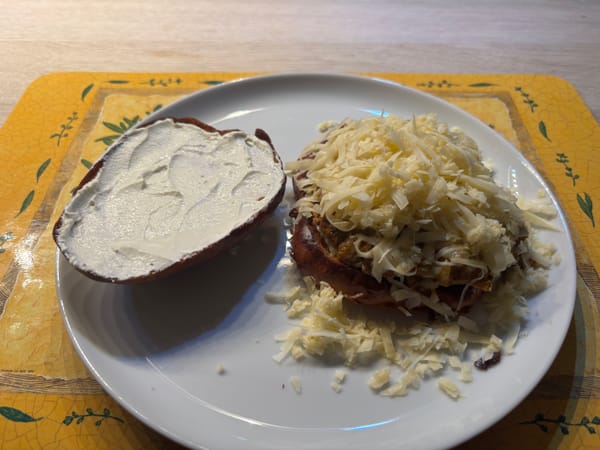You've probably heard the saying "you are, what you eat". It relates to the importance of our diets and the effect our foods can have on our development, performance, and, of course, health.
And despite seeming oversimplified, it is true.
We are, quite literally, what we eat. The minerals of our bones, proteins in our muscles, the vitamins and fats. Everything that makes up our bodies, even the water, is derived purely from what we eat and drink. After all, unlike plants, we can't fixate organic matter, like carbon, from the air. And our bodies don't break the principles of thermodynamics either. So all the mass that we humans are made up of has to come from the food and drink we consume.
Given the fact that all our food passes through our intestines before being absorbed, it's no wonder that intestinal health is often discussed with regard to its impact on diseases, including, of course, cancer.1
And that's what we're going to talk about today.
How does intestinal health affect cancer, how can our diets affect intestinal health, and how can we improve our intestinal health to help our chances against cancer.
First, we have to understand what exactly the purpose of our intestines is. What do healthy intestines do, that unhealthy intestines don't and how can this impact our bodies at large.
If you aren't well acquainted with human anatomy, you might not know that the cells that make up our intestinal lining are part of the same class of cells, as those of our skin, the epithelial cells.2 The central function of all epithelial cells is to separate your internal tissues from the external environment.3 By doing this, they enable your body to maintain the specific conditions required by our cells for survival and function, even in the presence of significant environmental changes.
This separation of the inside and outside world includes providing a barrier against foreign matter, such as dirt, parasites, fungal spores, bacteria and viruses. Without our epithelia, all of these would have a far easier time entering our body and disturbing the carefully maintained homeostasis.3
We publish new articles, whenever we've synthesised new findings to a usable degree. You can subscribe to receive articles for free.
As an aside, this is one of the reasons that animal cells require much more care to cultivate in a laboratory setting than bacteria. They are used to the stability that the epithelial barrier provides and are thus unable to properly deal with any significant disturbances, whether that be temperature, moisture, a bacterial contamination, or anything else.4
In order to create an impassable barrier, epithelial cells utilise something called tight junctions. These are protein bridges that link the individual cells and fill the gaps between them, so that bacteria and foreign material cannot simply squeeze through these gaps between the cells. You can imagine these tight junctions, like the mortar used between bricks when building a wall. If you were to build a tub out of bricks, without using mortar, water could simply seep through the gaps. The same applies to the cells and the tight junctions.5
Beside having to perform these tasks, the intestinal epithelia have another purpose. They have to enable the selective absorption of nutrients without compromising the barrier function. This capability of our intestinal epithelia is referred to as selective permeability.6
In order to achieve this, the gut lining is composed of only a single layer of epithelial cells .7 This trait enables it to more easily absorb nutrients, as they don't have to pass through multiple layers of cells. However, being made up of only a single layer of cells makes our intestinal lining much more sensitive to damage, compared to our skin, which is composed of multiple layers, including several top layers of dead, keratinised cells.8 The cells of our gut lining also express transporter and channel proteins, to allow active pumping and passive diffusion of nutrients into the bloodstream without significantly increasing permeability to other matter.
Poor intestinal health leads to a reduction of selective permeability and through this impacts overall wellbeing. Among many other diseases, poor intestinal health has been shown to increase the risk of cancer.9 Most research into this connection is focused on poor intestinal health promoting gastrointestinal cancers, with limited research into its effects on other types of cancers. Nonetheless, it seems likely that poor intestinal health would affect severity and risk of cancers as a whole.10
This is because poor intestinal health induces chronic inflammation, which has been linked with higher cancer risk and severity.11-16 Additionally, chronic inflammation can lead to immune senescence, which enables cancer immune evasion and reduces anti cancer immunity.
To understand how this happens, we'll have to look a bit closer at the epithelial cells. Like I mentioned earlier, the tight junctions are an integral part of all epithelial barriers. It just so happens that compounds found in some foods, such as lectins and prolamins attack the tight junctions and reduce their stability.17, 18 The most well-known of these is likely gluten, a type of prolamin.
Gliadin, a component of gluten, can bind to CXCR3, a receptor protein found on the surface of epithelial cells. Once gliadin binds to this receptor it triggers the secretion of zonulin from the epithelial cells. Zonulin then causes the breakdown of the tight junctions, which increases the permeability of the gut.18 Whilst more pronounced in people diagnosed with a gluten allergy, this reaction occurs in all humans.18 The mechanism isn't the same for every prolamin or lectin, however, the effects on the tight junctions are similar, with only a few exceptions.
Alcohol is another extremely common compound that has been shown to reduce selective permeability by reducing tight junction integrity. 19, 20
Besides food compounds, illnesses and infections can also alter tight junction stability and increase intestinal permeability.
A more permeable gut allows for a higher rate of translocation of bacteria, bacterial toxins and other foreign matter, such as undigested carbohydrates or proteins from the food, into the body. The presence of these foreign substances in the body activate the immune system. The main problem arises when gut permeability is elevated over a long period of time. In this case, the constant influx of new foreign substances means that the immune system can't ever clear them out completely and remains activated. This leads to chronic inflammation, which in turn promotes cancer, immune senescence and immune evasion.7
We don't take sponsoring or display advertisements in order to keep us free from conflicts of interest. If you've found this valuable, you can help us by supporting our fight against cancer financially.
The details of this interplay between chronic inflammation, the immune system and cancer are extremely complex. Because of this, I won't delve into them right now. Rather I will devote a different article to this topic entirely. (Once published I will come back and put a link in here.) Still, it is safe to say that chronic inflammation has a negative effect on cancer patient outcomes.11-16
Because of this, minimising chronic inflammation is an obvious goal. By extension, this means improving intestinal health and selective permeability to minimise translocation of foreign substances into the body.
The factor which is easiest for us to control is the elimination of food compounds that reduce tight junction integrity. Completely eliminating illnesses or infections is much harder, as they are less easily controlled. Food compounds by comparison can be almost completely controlled, simply by changing what we eat to eliminate foods that contain them. On top of this, illnesses and infections are likely to only temporarily reduce tight junction integrity, thus contributing less to chronic inflammation. Of course, improving overall immune system function to reduce the risk of infections still benefits gut health. Lastly, a more intact intestinal barrier as a result of less food-related tight junction disruption enables your body to better deal with any intestinal infections or illnesses.
As mentioned earlier, lectins and prolamins are two widespread classes of compounds found in foods that generally disrupt tight junctions.17–8 Prolamins are mainly found in cereals, such as wheat, barley and rye. Beyond eliminating prolamins, cutting out cereals is also necessary to induce ketosis due to their carbohydrate content. Since ketosis has been shown to be beneficial to cancer patient survival, abstinence from cereals serves a dual purpose.
Lectins are more various, with no single food group holding a monopoly. They are mainly found in cereals, legumes, such as peanuts and kidney beans, nightshade vegetables, and squashes.
Animal foods don't contain any prolamins and lectins and are thus always viable to eat. Additionally, leafy vegetables and cruciferous vegetables don't contain significant amounts of lectins or prolamins. However, oxalates may be a concern in some of them.
As for alcohol, I think everyone knows where it can be found, alcoholic beverages or food containing these.
Overall, eliminating cereals, legumes, nightshades, squashes, and alcohol is a great starting point to improve intestinal health. Other foods, need to be individually examined with regard to their prolamin and lectin content, before the benefit of elimination can be ascertained.
As always, it's a balancing act. The more complete the elimination of gut irritants is, the better the results will be. At the same time, such an elimination is more difficult to maintain. I recommend working in descending order, starting with the most significant foods and working towards those with lesser impact, with the goal eliminate as many of the irritants as possible.
And I think that concludes this article. If you have any questions or feedback, do leave a comment to let me know.
I wish you swift healing and lasting health.
Cheers,
Cedric.
References
- Wang H, Bai J, Miao P, Wei Y, Chen X, Lan H, et al. The key to intestinal health: a review and perspective on food additives. Front Nutr [Internet]. 2024 Sept 18 [cited 2025 Sept 23];11. Available from: https://www.frontiersin.org/journals/nutrition/articles/10.3389/fnut.2024.1420358/full
- Peterson LW, Artis D. Intestinal epithelial cells: regulators of barrier function and immune homeostasis. Nat Rev Immunol. 2014 Mar;14(3):141–53.
- Higashi T, Saito AC, Chiba H. Damage control of epithelial barrier function in dynamic environments. European Journal of Cell Biology. 2024 June 1;103(2):151410.
- Weiskirchen S, Schröder SK, Buhl EM, Weiskirchen R. A Beginner’s Guide to Cell Culture: Practical Advice for Preventing Needless Problems. Cells. 2023 Jan;12(5):682.
- Tervonen A, Ihalainen TO, Nymark S, Hyttinen J. Structural dynamics of tight junctions modulate the properties of the epithelial barrier. PLOS ONE. 2019 Apr 9;14(4):e0214876.
- Suzuki T. Regulation of intestinal epithelial permeability by tight junctions. Cell Mol Life Sci. 2013 Feb 1;70(4):631–59.
- Dmytriv TR, Storey KB, Lushchak VI. Intestinal barrier permeability: the influence of gut microbiota, nutrition, and exercise. Front Physiol [Internet]. 2024 July 8 [cited 2025 Sept 23];15. Available from: https://www.frontiersin.org/journals/physiology/articles/10.3389/fphys.2024.1380713/full
- Kurn H, Daly DT. Histology, Epithelial Cell. In: StatPearls [Internet]. Treasure Island (FL): StatPearls Publishing; 2025 [cited 2025 Sept 23]. Available from: http://www.ncbi.nlm.nih.gov/books/NBK559063/
- Genua F, Raghunathan V, Jenab M, Gallagher WM, Hughes DJ. The Role of Gut Barrier Dysfunction and Microbiome Dysbiosis in Colorectal Cancer Development. Front Oncol [Internet]. 2021 Apr 15 [cited 2025 Sept 23];11. Available from: https://www.frontiersin.org/journals/oncology/articles/10.3389/fonc.2021.626349/full
- Pevsner-Fischer M, Tuganbaev T, Meijer M, Zhang SH, Zeng ZR, Chen MH, et al. Role of the microbiome in non-gastrointestinal cancers. World J Clin Oncol. 2016 Apr 10;7(2):200–13.
- Aggarwal, B.B., and Gehlot, P. Inflammation and cancer: how friendly is the relationship for cancer patients?
- Kamp, D.W., Shacter E Fau - Weitzman, S.A., and Weitzman, S.A. Chronic inflammation and cancer: the role of the mitochondria.
- Laird, B.J., McMillan Dc Fau - Fayers, P., Fayers P Fau - Fearon, K., Fearon K Fau - Kaasa, S., Kaasa S Fau - Fallon, M.T., Fallon Mt Fau - Klepstad, P., and Klepstad, P. The systemic inflammatory response and its relationship to pain and other symptoms in advanced cancer.
- Murata, M. Inflammation and cancer.
- Zhao, H., Wu, L., Yan, G., Chen, Y., Zhou, M., Wu, Y., and Li, Y. (2021). Inflammation and tumor progression: signaling pathways and targeted intervention. Signal Transduction and Targeted Therapy 6, 263. 10.1038/s41392-021-00658-5.
- López-Armada, M.J., Riveiro-Naveira, R.R., Vaamonde-García, C., and Valcárcel-Ares, M.N. (2013). Mitochondrial dysfunction and the inflammatory response. Mitochondrion 13, 106-118. https://doi.org/10.1016/j.mito.2013.01.003.
- Freed, D.L. (1999). Do dietary lectins cause disease? Bmj 318, 1023-1024. 10.1136/bmj.318.7190.1023.
- Lammers, K.M., Lu, R., Brownley, J., Lu, B., Gerard, C., Thomas, K., Rallabhandi, P., Shea-Donohue, T., Tamiz, A., Alkan, S., et al. (2008). Gliadin induces an increase in intestinal permeability and zonulin release by binding to the chemokine receptor CXCR3. Gastroenterology 135, 194-204.e193. 10.1053/j.gastro.2008.03.023.
- Elamin E, Masclee A, Dekker J, Jonkers D. Ethanol disrupts intestinal epithelial tight junction integrity through intracellular calcium-mediated Rho/ROCK activation. American Journal of Physiology-Gastrointestinal and Liver Physiology. 2014 Apr 15;306(8):G677–85.
- Bjarnason, I., Ward, K., and Peters, T. (1984). THE LEAKY GUT OF ALCOHOLISM: POSSIBLE ROUTE OF ENTRY FOR TOXIC COMPOUNDS. The Lancet 323, 179-182. 10.1016/S0140-6736(84)92109-3.










